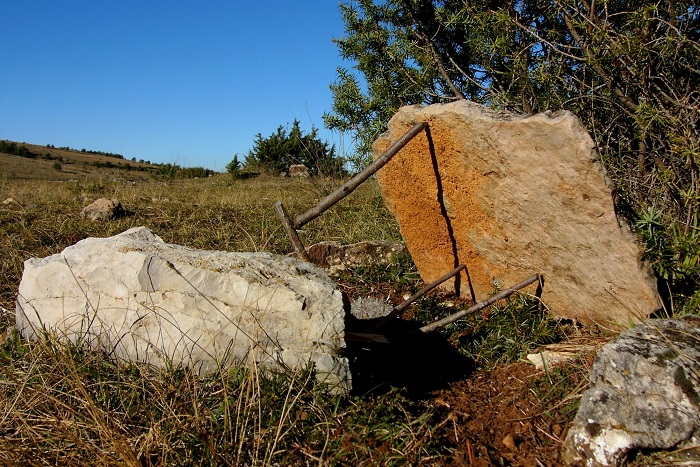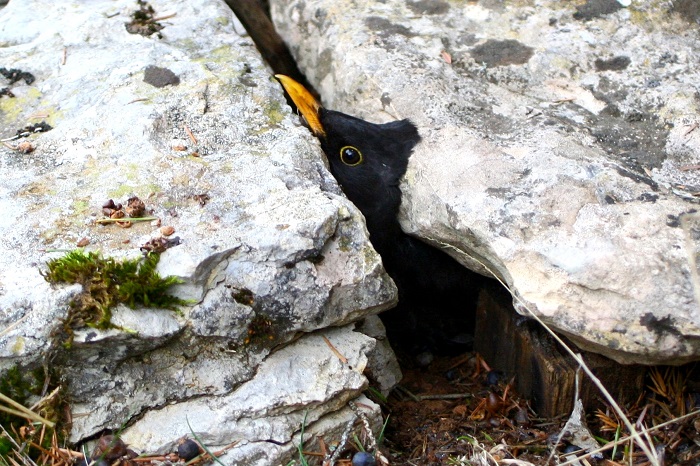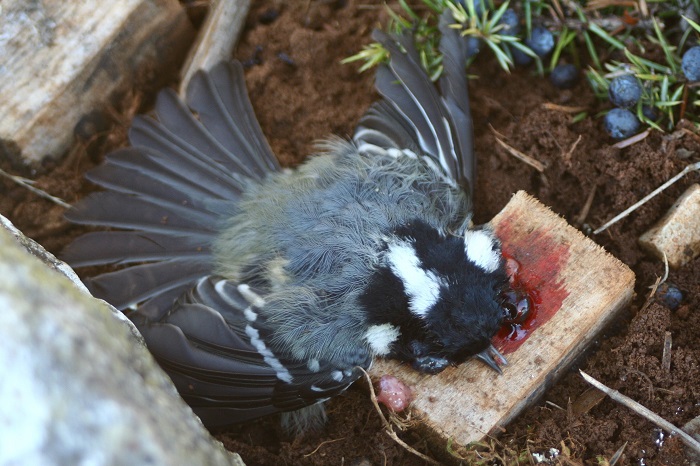Stone-crush traps in the french Central Massif

In the French Central Massif, an ancient method of catching birds has survived for thousands of years: rockfall traps, "tendelles" in French. They were banned for over 100 years, but the authorities never got a grip on the ongoing poaching. This only changed in November 2005, when stone-crush trapping was simply allowed again - the poachers became overnight custodians of a "traditional hunting method".
The now approved trapping is also one of the most brutal methods: Each trap consists of a limestone slab weighing around 3 to 10 kilograms, which is propped up with a construction of small sticks and baited with fresh juniper berries. Birds that try to eat the berries touch the sticks and are buried under the falling plate. Many birds are not killed immediately, but bleed to death, suffocate or die of thirst. Numerous animals die also from hypothermia, because in the high-altitude of the region, the temperatures don't rise over 0 degrees in the winter even during the day.

Fieldfare, redwing, song thrushes, mistle thrushes, and blackbirds can be trapped. But far too often protected birds are also among the victims, especially robins, coal tits, meadow pipits and chaffinches.
As these species are protected by the EU Birds Directive, the use of indiscriminate killing traps is strictly prohibited throughout Europe. Nevertheless, "tendelles" may now be set up again in 32 municipalities in southern France - officially around 20,000 traps.
The Paris Minister of the Environment justifies the authorisation with the development of a new trap model with which the smaller, protected birds can allegedly be caught alive but not killed. The French government has itself convinced the EU Commission in Brussels that the trapping method is selective with several 'expert' opinions.
CABS investigations in the Central Massif

Between December 2006 and January 2010, CABS members identified several dozen trapping sites with around 2,000 stone traps and documented their use. The aim was to verify the figures of the French government that led to the derogation being approved.
The result is clear: as expected, the traps did not only contain thrushes, but 10 % protected bird species - there is no question of "selectivity". The claim that protected birds would always be buried alive under the heavy limestone slabs could also be refuted: 75% of all captured birds were dead, whether thrushes or protected birds. Those who could be rescued alive were usually so badly injured that they could not be released again. Not a single living specimen of the protected species was found.
The catch quota, determined by the French government, also turned out to be far too low: the study presented in Brussels by the French Ministry of the Environment states that each bird trapper catches only 0.3 birds per day. With the 92 hunting days allowed, each hunter would catch only 27 birds per day - completely untrustworthy figures given the enormous effort involved. Our studies showed that with every single trapping system 2.25 birds can be caught daily, i.e. more than 200 animals during one season. With 20,000 approved traps this means 50,000 birds!
Even the French state hunting agency ONFCS has expressed considerable doubts about the studies carried out by its own government. The main criticism here is that almost all the figures presented on selectivity and catch rates were collected by the bird trappers themselves or obviously falsified by them. In other words, the poachers have been able to calculate their traps until they were "eligible for approval".
With the financial support of the German Animal Welfare Association, the Committee Against Bird Slaughter (CABS) has drawn up a comprehensive report on the stone traps and presented it to the EU Commission in Brussels.
Through lawsuits filed by our partner association LPO, the Supreme Court has declared the use of stone-crush traps illegal in 2021 and 2022. But there is no reason to sound the all-clear yet, as the government in Paris seems to continue looking for tricks to re-authorise bird trapping!






